

List of common misconceptions. From Wikipedia, the free encyclopedia This incomplete list is not intended to be exhaustive.

This list corrects erroneous beliefs that are currently widely held about notable topics. Each misconception and the corresponding facts have been discussed in published literature. Note that each entry is formatted as a correction; the misconceptions themselves are implied rather than stated. Arts and culture Food and cooking Roll-style Western sushi. Searing meat does not "seal in" moisture, and in fact may actually cause meat to lose moisture. Legislation and crime Literature The Harry Potter books, though they have broken children's book publishing records, have not led to an increase in reading among children or adults, nor slowed the ongoing overall decline in book purchases by Americans, and children who did read the Harry Potter books were not more likely to go on to read more outside of the fantasy and mystery genres.[21][22][23][24] Music Religion Hebrew Bible Buddhism Christianity Islam Sports.
Appeal to nature. An appeal to nature is an argument or rhetorical tactic in which it is proposed that "a thing is good because it is 'natural', or bad because it is 'unnatural'".[1]

Canary trap. A canary trap is a method for exposing an information leak by giving different versions of a sensitive document to each of several suspects and seeing which version gets leaked.
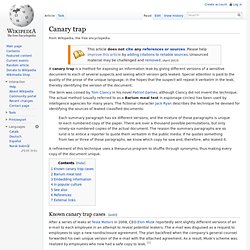
Special attention is paid to the quality of the prose of the unique language, in the hopes that the suspect will repeat it verbatim in the leak, thereby identifying the version of the document. Each summary paragraph has six different versions, and the mixture of those paragraphs is unique to each numbered copy of the paper. There are over a thousand possible permutations, but only ninety-six numbered copies of the actual document. Oseberg ship. The Oseberg ship (Viking Ship Museum, Norway) Detail from the Oseberg ship View from the front.
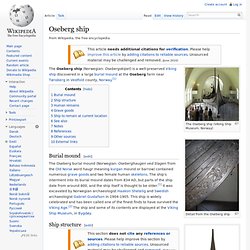
Alpher–Bethe–Gamow paper. In physical cosmology, the Alpher–Bethe–Gamow paper, or αβγ paper, was created by Ralph Alpher, then a physics PhD student, and his advisor George Gamow.
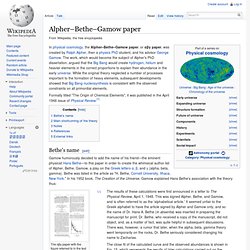
The work, which would become the subject of Alpher's PhD dissertation, argued that the Big Bang would create hydrogen, helium and heavier elements in the correct proportions to explain their abundance in the early universe. While the original theory neglected a number of processes important to the formation of heavy elements, subsequent developments showed that Big Bang nucleosynthesis is consistent with the observed constraints on all primordial elements.
Lanchester's laws. Lanchester's laws are mathematical formulae for calculating the relative strengths of a predator/prey pair.
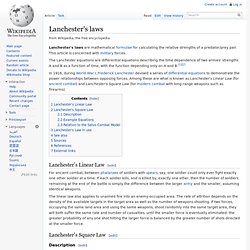
This article is concerned with military forces. The Lanchester equations are differential equations describing the time dependence of two armies' strengths A and B as a function of time, with the function depending only on A and B.[1][2] In 1916, during World War I, Frederick Lanchester devised a series of differential equations to demonstrate the power relationships between opposing forces. Jerrycan. German containers for 20 litres of fuel. left: former container, right: Wehrmacht-Einheitskanister of 1941, manufacturer: Nirona A jerrycan (also written as jerry can or jerrican) was originally a robust fuel container made from pressed steel.
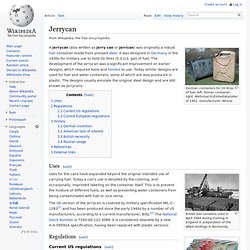
It was designed in Germany in the 1930s for military use to hold 20 litres (5.3 U.S. gal) of fuel. The development of the jerrycan was a significant improvement on earlier designs, which required tools and funnels to use. Today similar designs are used for fuel and water containers, some of which are also produced in plastic. The designs usually emulate the original steel design and are still known as jerrycans. U 977. Ant mill. An ant mill is an observed phenomenon in which a group of army ants separated from the main foraging party lose the pheromone track and begin to follow one another, forming a continuously rotating circle.

The ants will eventually die of exhaustion. This has been reproduced in laboratories and the behaviour has also been produced in ant colony simulations.[1] This phenomenon is a side effect of the self-organizing structure of ant colonies. Each ant follows the ant in front of it, and this will work until something goes wrong and an ant mill forms.[2] An ant mill was first described by William Beebe in 1921 who observed a mill 1,200 feet (365 m) in circumference.[3] It took each ant 2.5 hours to make one revolution.[4] Similar phenomena have been noted in processionary caterpillars and fish.[5] See also[edit] References[edit] External links[edit]
Predestination paradox. A predestination paradox (also called causal loop, causality loop, and, less frequently, closed loop or closed time loop) is a paradox of time travel that is often used as a convention in science fiction.

It exists when a time traveler is caught in a loop of events that "predestines" or "predates" him or her to travel back in time. Mikhail Devyatayev. Mikhail Petrovich Devyatayev (Russian: Михаил Петрович Девятаев; Moksha/Erzya: Михаил Петрович Девятаев; 8 July 1917 in Torbeyevo, Tambow Governorate, Russia (today Mordovia, Russia);– 24 November 2002, Kazan, Tatarstan, Russia) was a Soviet fighter pilot known for his incredible escape from a Nazi concentration camp on the island of Usedom, in the Baltic Sea.
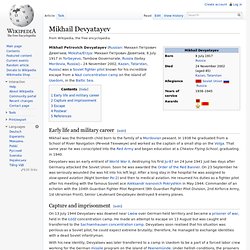
Early life and military career[edit] Mikhail was the thirteenth child born to the family of a Mordovian peasant. List of songs containing the I-V-vi-IV progression. I-V-vi-IV pop-punk chord progression in C Play . List of ineffective cancer treatments. List of common misconceptions. Coital cephalalgia. Sentinelese people. The Sentinelese (also Sentineli, Senteneli, Sentenelese, North Sentinel Islanders) are an indigenous people of the Andaman Islands, in the Bay of Bengal. They inhabit North Sentinel Island, which lies westward off the southern tip of the Great Andaman archipelago. They are noted for resisting attempts at contact by outsiders. The Sentinelese maintain an essentially hunter-gatherer society subsisting through hunting, fishing, and collecting wild plants. Ozymandias. A fair copy draft (c. 1817) of Shelley's "Ozymandias" in the collection of Oxford's Bodleian Library Ozymandias (in five syllables /ˌɒziˈmændiəs/ or four syllables /ˌɒziˈmændjəs/)[1] is a sonnet written by the English romantic poet Percy Bysshe Shelley (1792–1822).
First published in the 11 January 1818 issue of The Examiner[2] in London, it was included the following year in Shelley's collection Rosalind and Helen, A Modern Eclogue; with Other Poems (1819)[3] and after his death in a posthumous compilation of his poems published in 1826.[4] Ozymandias is regarded as one of Shelley's most famous works and is frequently anthologised. Writing and publication history[edit] Publication history[edit]
July 12, 2007 Baghdad airstrike. The July 12, 2007 Baghdad airstrikes were a series of air-to-ground attacks conducted by a team of two United States Army AH-64 Apache helicopters in Al-Amin al-Thaniyah, in the district of New Baghdad in Baghdad, during the Iraqi insurgency which followed the Iraq War. The attacks received worldwide coverage following the release of 39 minutes of classified cockpit gunsight footage in 2010. In the first strike, the crew of the two Apaches directed 30mm cannon fire at a group of ten men in the path of advancing U.S. Army ground troops. Some were armed with RPGs, AKMs, some carried extra RPG warheads with no launcher, while others may have been unarmed.[7][8][9] Among the group were two Iraqi war correspondents working for Reuters, Saeed Chmagh and Namir Noor-Eldeen. Noor-Eldeen's camera was misidentified as an RPG pointed at U.S. soldiers when he attempted to photograph the soldiers moving toward the armed group while crouching behind a building.
Bellum se ipsum alet. Laws of war. Dihydrogen monoxide hoax. The subject of the hoax, water molecules, consist of two hydrogen atoms and one oxygen atom. Gödel's ontological proof. Michael Malloy. Michael Malloy (1873 – February 22, 1933), alias Mike the Durable and Iron Mike, was a homeless Irishman from County Donegal who lived in New York City during the 1920s and 30s.[1][2] Although he was a former firefighter, he is most famous for surviving a number of attempts on his life by five acquaintances, who were attempting to commit life insurance fraud.[1][3] War Is a Racket. Sensitive Compartmented Information Facility. Dunning–Kruger effect. Cognitive bias about one's own skill. Mike Alder. Rosenhan experiment. Stellar Wind (code name) Godwin's law.
Fractal antenna. P versus NP problem. Dilawar (torture victim) Rotfrontkämpferbund. Guru Meditation. Just-world hypothesis. Exception that proves the rule. Kurt Vonnegut. Eddie Slovik. Ennigaldi-Nanna's museum. Battle of Camarón. Schmücker-Prozess. Celler Loch. Zentralrat der umherschweifenden Haschrebellen. List of Middle-earth weapons and armour. Genie (feral child) Windscale fire. Arena (countermeasure) Numbers station. Vegvísir. Gimli Glider. Category:Military strategy. Lykov family. Hanns Scharff. Penrose triangle. Malbolge. Tradecraft. High-altitude nuclear explosion. List of biases in judgment and decision making. Apophenia.
Hofstadter's law. Conch Republic. Argument from silence. The Three Christs of Ypsilanti. Bellerophon. Best of all possible worlds. Summis desiderantes affectibus. Dyatlov Pass incident. Flying Spaghetti Monster. Sherman's neckties. Liquid breathing.
Crime. Military. Philosophy. Celine's laws. Art. Pigasus (literature) Tears in rain soliloquy. History. Cautio Criminalis. Mythology. Science. List of German inventors and discoverers. Mike Hailwood. 136 Creepy Wikipedia Articles. James Jesus Angleton. Curveball (Informant) ThinThread. Buffalo buffalo Buffalo buffalo buffalo buffalo Buffalo buffalo - Wikipedia, the free encyclopedia - StumbleUpon.